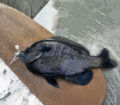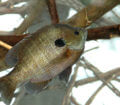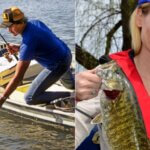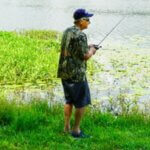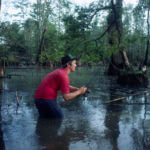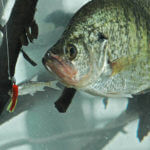Editor’s Note: Most fishermen, especially those in the Deep South, will name May and June as the months for catching big bream, and particularly the time around the times of the full moon. But, to catch bluegills that weigh almost 5 pounds, certain conditions have to come together to produce a new world-record bluegill. Just like you can’t take a trophy whitetail, if a trophy whitetail doesn’t live on the property you hunt, the same is true for catching monster-sized bream. This week let’s look at what ingredients must come together to produce a big bream, which for most of us would be a 1-1/2 to 2-pounder.
One of the largest bream ever caught was a 4-pound 12-ounce monster taken almost 70-years ago in 1950 from Ketona Lake near Birmingham, Alabama. In 1947, Coke McKenzie of Birmingham caught a 4-pound 10-ounce bluegill at Ketona Lake that was 15-1/4 inches long and 8-inches wide. The previous world record at that time was only 2 pounds, 8 ounces. Three weeks later a 3-1/2-pound bluegill also was taken from the same lake. And, before the year was out, a 2-pound 8-ounce bream was boated there. Then, in 1950, T.S. Hudson, also of Birmingham, caught a new world-record bream from Ketona that tipped the scales at 4 pounds, 12 ounces. What was the magic formula that produced these buster bream? Can these conditions be produced somewhere else? The answer is a very-definite, “Yes.” Lake Ketona, home of two world’s record Lepomis Macrochirus, was a deep, clear limestone quarry that had a small spawning area around the ledges of the deep quarry. Too, the bass population in this now-closed lake was high.
During the spring and summer, most anyone can catch bream, which will be around piers, under willow trees and in most shallow water. In the more-rocky terrains, they will be in little pools and shady spots on the side of the rocks and boulders and under the rocks waiting on the bait to pass by. These will be the average to small bream – the bream that anyone can catch, and that most breamers do catch. “But to catch trophy bluegills, the best place to start is to fish a heavily-fertilized farm pond with a crowded bass population,” my longtime friend, fisheries biologist Sam Spencer, once told me. “If a lake or a pond has low numbers of bream, then those bream have more food available and can grow to a larger size. By increasing the number of prey fish in a body of water, you insure that only a small number of bream offspring will survive, thereby providing more food for the adult bream. Consequently the waters will home fewer bream – but they will be bigger.”
Bluegills start spawning during the late spring, once the temperatures reach 72-78 degrees and will spawn until early fall. Many anglers say they can smell the bluegill beds once the fish start spawning and describe the smell as watermelon-like.
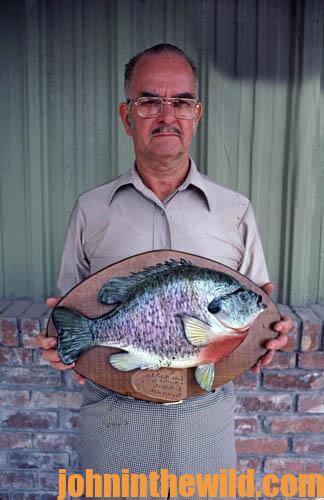 The subtle mistakes that most bream anglers make are the mistakes that the big bream key in on and avoid. For instance, oftentimes, large, smart bream can spot hooks in baits. So, one of the tactics that may work the best on big bream is to bury or camouflage the hook as much as possible in the bait. This action may mean utilizing much-smaller hooks than most breamers assume are necessary for catching really-big bream. Many anglers also have found that big bream can see big line, so, sportsmen feel that 2- or 4-pound-test line is much better for taking big bream than 6- or 8-pound-test line is.
The subtle mistakes that most bream anglers make are the mistakes that the big bream key in on and avoid. For instance, oftentimes, large, smart bream can spot hooks in baits. So, one of the tactics that may work the best on big bream is to bury or camouflage the hook as much as possible in the bait. This action may mean utilizing much-smaller hooks than most breamers assume are necessary for catching really-big bream. Many anglers also have found that big bream can see big line, so, sportsmen feel that 2- or 4-pound-test line is much better for taking big bream than 6- or 8-pound-test line is.
Big bream are extremely wary, and Lake Ketona was crystal clear. So, the men who took the records had to overcome the fish’s ability to see them, if they were to land the lunkers. Using light line, no weights and a glob of worms that completely hid their hooks, these big bream anglers hid on the bank. The men cast out their baits, and as the worms gently floated-down to the bottom, the anglers watched for twitches on their lines to signify strikes. This hide-and-wait tactic worked twice for world-record bream fishermen. This same system also catches bedding bluegills in clear farm ponds with no trees or vegetation around the bank.
One time a friend of mine and I had found a large concentration of bedding bream close to the bank in crystal-clear water. The grass around the bank had been mowed, so there were no trees or bushes to hide behind. To get close enough to the bream to present my bait without spooking them, I had to make a 30-yard belly crawl. Once within casting distance of the bream, I attached a clear, plastic cork, 3-feet up my line from the hook. Since I knew that the bottom was at 2-1/2 feet, I wanted enough line below the cork, so that my bait could lie easily on the bottom, once it had sunk. I used the smallest bream hook I had and no lead. I threaded a large red worm onto the hook buried deep inside the worm’s body.
When I cast the worm out, the clear-plastic cork hit the surface and was almost invisible to a bream looking-up. The worm floated-down freely, because there was no lead to snatch it quickly to the bottom. I was using the cork not to float the bait off the bottom, but to indicate a strike. From where I laid on the ground, I could watch the float. However, the fish couldn’t see me. As the bobber twitched, I gently set the hook on my 2-pound-test line and began to slowly and steadily retrieve the bream. Crawling to the edge of the water when the battle was over, I retrieved my bream, placed it on a long stringer and put it back in the water, in another section of the pond. I rolled-over on my back, put a new worm on the hook, cast-out and began to fish again. Using this tactic, I was able to take 20-trophy-sized bream before the evening ended “That’s a lot of trouble to go through to catch bream,” my friend observed. I agreed, but the size of the bream I was taking made it worthwhile.
I have friends who enjoy fishing for big bream at clear, spring-fed Merritt’s Mill Pond in northwest Florida in Marianna. Those bream are often caught on very-light line, while fishing at night, so that the bream can’t see the anglers overhead.
 Here are places avid breamers consider some of the best for catching for catching big bream in the U.S.
Here are places avid breamers consider some of the best for catching for catching big bream in the U.S.
* Richmond Hill Lake in North Carolina – This private lake that costs $600 per day to fish contains numbers of 2-pound bluegills and has been managed for big bass and bluegills.
* Lake Havasu on the Colorado River in Arizona and California – The world-record redear weighing 5.78-pounds was caught in this clear-water lake in 2014, and a 16-inch, about 3-pound bluegill was caught there in 2017. Some anglers have speculated that the mussels in the lake are responsible for the large bream weights.
* C.J. Strike Reservoir in Idaho – This 7500-acre lake homes numbers of big crappie too and is where the Idaho state record, a 3-pound, 8-ounce fish, was caught in 1966.
* Goldwater Lake near Prescott, Arizona – Only 15 acres in size, this lake only allows boats with electric motors, kayaks and/or canoes for fishing but homed the Arizona state record bluegill, caught in 2004, weighing 3 pounds, 15 ounces.
Very-few breamers will drag an aluminum boat over a muddy bank to get into an oxbow slough to fish for bream. But, that’s what many Gulf Coast breamers do to catch big bream every year. As one angler told me, “To catch big bream, you have to get to the fish that no one else can find, like those in the swampy waters in the Delta section of south Alabama. These bream haven’t been picked-over, and they usually will be more-aggressive than the bream you’ll find in big river systems.”
Also many bull bream live in brackish water along the bays, rivers and channels that feed into salt water. Although the little brackish-water bream are easy to catch, the big bream often can be very difficult to take. According to my late friend and avid bream fisherman on the Gulf Coast, Les Maske, “You have to use seed shrimp – those tiny little shrimp that you see up in the eel grass at the mouths of rivers, coves and sloughs in brackish water. Most of the time, those little-bitty shrimp won’t be more than 1/4-inch long. You must use fine hair hooks to hook the seed shrimp through the tail or the horn. The weight of the hook usually will carry the bait down to where the big bream lurk. The big bream are accustomed to eating the small seed shrimp. Oftentimes when they shy-away from worms and crickets, they’ll latch onto the seed shrimp. If I’m fishing a spot that I know other anglers have been angling heavily, like a boathouse, a pier or a well-known bream bed, I’ll use a really-light, limber fiberglass pole with no lead, no cork and 2-pound-test line. I’ll throw the bait out over my head to the area I want to fish. Then, I’ll let the line sink naturally. When that bream sees that small grass shrimp swimming down, naturally the fish will attack.”
 Yet another spot to take bigger bream is in boathouses where the problem is usually culling the smaller bream. Generally boathouses are full of small bream and home only a few bigger bream. As you try to catch the big bream, the little bream will run out, grab your bait and either be caught or get off scot-free while the bigger bream sit back and watch the action. Most of the time, the anglers who continue to catch little bream are using big lines, a lead, a visible cork and small worms. By utilizing a bigger worm, a smaller hook, very-small line and no cork at all, an angler can present the worm more naturally to the bigger bream that usually will come-up and take the bait.
Yet another spot to take bigger bream is in boathouses where the problem is usually culling the smaller bream. Generally boathouses are full of small bream and home only a few bigger bream. As you try to catch the big bream, the little bream will run out, grab your bait and either be caught or get off scot-free while the bigger bream sit back and watch the action. Most of the time, the anglers who continue to catch little bream are using big lines, a lead, a visible cork and small worms. By utilizing a bigger worm, a smaller hook, very-small line and no cork at all, an angler can present the worm more naturally to the bigger bream that usually will come-up and take the bait.
Stocked farm ponds also provide opportunities to catch big bream. My longtime friend, Barry Smith, a fisheries biologist and former owner of American Sportsfish, recommends you stock your farm pond with coppernose bluegills that are well-adapted to pond environments and grow quickly.
Filleting a bluegill: https://www.facebook.com/murray.ragan/videos/2166724223418205
 To learn recipes for cooking bream and other freshwater fish, check out John E. Phillips’ Kindle cookbook, “13 Freshwater Fish Recipes You Can’t Live Without” at http://amzn.to/18OiC9v. For information on any type of fishing, visit https://johninthewild.com/books.
To learn recipes for cooking bream and other freshwater fish, check out John E. Phillips’ Kindle cookbook, “13 Freshwater Fish Recipes You Can’t Live Without” at http://amzn.to/18OiC9v. For information on any type of fishing, visit https://johninthewild.com/books.

